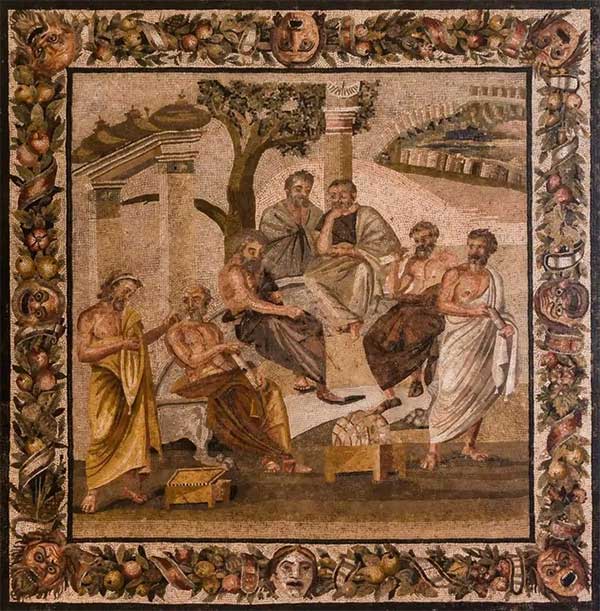AI-decoded carbonized scroll reveals Plato's final resting place
The scroll's contents may offer new perspectives on Plato's philosophy. Details about the last night of his life can help us better understand his thoughts and perspectives in his final moments.
Plato (circa 428/427 BC - 348/347 BC) was an ancient Greek philosopher, considered one of the greatest and most influential thinkers in human history. He is not only famous for his great contributions to philosophy but also contains many mysteries that researchers and scholars are always curious to explore.
Recently, a group of researchers used advanced technology to decode the secrets from the carbonized scroll buried after the eruption of Mount Vesuvius (Herculaneum scroll) in 79 AD. This scroll, believed to have been written by Philodemus of Gadara, a poet and philosopher who lived in Herculaneum, provides new details about Plato's final resting place and even his last night.

Plato's Academy mosaic (from Pompeii, c. 100 BC to 100 AD), where the philosopher was buried.
Using optical coherence tomography, infrared hyperspectral imaging and machine learning, researchers from the Greek Schools research project were able to scan the characters are "stuck" in the carbonized scroll. They deciphered about 1,000 words, shedding light on Plato's final days and death.
Previously, we knew Plato was buried at Plato's Academy, the philosophical academy he founded in Athens, but the exact location of his burial remained a mystery. However, an ancient scroll from the city of Herculaneum, similar to Pompeii, which was devastated by the eruption of Vesuvius, has now provided researchers with a new clue.
According to Professor Graziano Ranocchia, the project's lead researcher, the text describes Plato as being laid to rest in a private garden near the temple of the Muses of Plato's Academy. This private garden is considered a sanctuary dedicated to Plato on the school campus.

Image of carbonized papyrus fragments found in Herculaneum, buried in ash after the eruption of Mount Vesuvius 1,945 years ago.
The scroll also provides a glimpse into Plato's final hours. Although we previously knew he died around 347 BC, details about his passing are scarce. The newly deciphered text shows that Plato spent his last evening listening to music, but with a characteristic twist. Even in his weakened state, the philosopher was able to find fault with the musician's rhythm. This anecdote, while seemingly trivial, offers a fascinating perspective on Plato's character - a man who was devoted to reason and order even in his final moments.
Interestingly, this scroll also challenges previous beliefs about Plato's life. Before this discovery, historians believed that Plato was sold into slavery in Sicily around 387 BC. However, information from this scroll suggests that he may have been enslaved earlier , possibly on the island of Aegina in 404 BC or 399 BC. Changes in the timeline may prompt a reassessment of certain periods in Plato's life.

Optical rendering of a carbon ghost roll. This visualization includes six rounds of AI training, where each column is separated as a prediction and evaluation column.
Another interesting aspect of the research is the technology used to decipher the scroll. Due to their age, the more than 1,800 carbonized papyrus scrolls, preserved in ash from the 79 AD eruption of Mount Vesuvius in the Villa Papyrus at Herculaneum, could not be opened directly as this would causing them to be completely destroyed.
Initial attempts to open scrolls discovered by a farm worker in 1750 resulted in them being destroyed, leaving the contents lost forever. However, last year marked an important breakthrough when the word "purple" was decoded for the first time from an unopened papyrus scroll, bringing a reward of $40,000 to the person who did it.
In 2015, at the University of Kentucky, data was extracted from a sealed Dead Sea scroll using X-ray tomography and computer vision technology, combined with artificial intelligence. Similarly, for the Herculaneum scrolls, artificial intelligence was used to determine the location of the ink on the unopened papyri and decipher them.
The Herculaneum scrolls remain a treasure trove of ancient knowledge, offering glimpses of the past. Although deciphering these fragile artifacts is a difficult process, the rewards are great. In Plato's case, we gain a deeper appreciation for the man behind this philosophy, and perhaps even a new respect for his musical criticism!
- Resting place of 13 Chinese emperors
- The burial place of Queen Cleopatra and her lover are about to be revealed?
- Controversy about where to bury Jesus
- The mysteries behind King Tut .'s golden mask
- City of dead people under the ocean
- Surprise with the future 'resting place' of the International Space Station
- Treating textile wastewater with carbonized coal
- Video: Giant scroll clouds across the Pacific Ocean
- Italy traced the 1.2 billion USD treasure of the king who once occupied Rome
- 'The 8th natural wonder' was wiped out by the volcano and hoped to recover after a hundred years of burial
- Mysterious vampire in Highgate cemetery
- Olive seeds that have carbonized can be used in construction
 Discovered an ancient centipede fossil 99 million years old
Discovered an ancient centipede fossil 99 million years old Discovered bat-like dinosaurs in China
Discovered bat-like dinosaurs in China Discovered a 200-year-old bronze cannon of the coast
Discovered a 200-year-old bronze cannon of the coast Discover 305 million-year-old spider fossils
Discover 305 million-year-old spider fossils